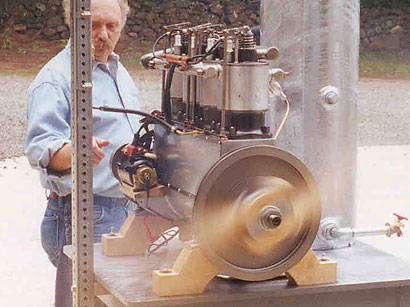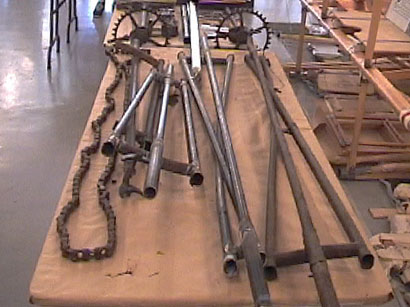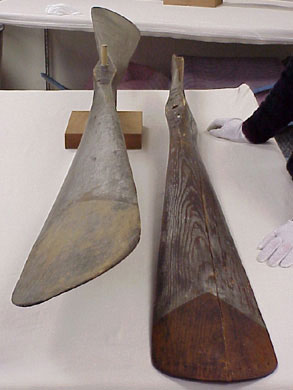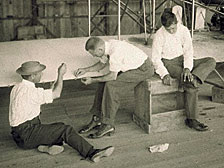Artifacts in Use by The Wright Experience
The following are some of the many Wright artifacts we have studied in depth from a variety of collections, including the Wright Experience, the Wright Family, the Dayton Engineer’s Club, and the National Park Service.
1901 Vertical Four Engine, Serial #20

This engine is the only operating original Wright engine in the world. It was collected in 1999 and restored by Greg Cone of the Wright Experience. Other than minor parts like nuts, bolts, and spark plugs, all its parts are original. Owned by the Wright Experience, it has been tested in a dynamometer in the Delphi Automotive Labs in Rochester, NY, and produces about 35 horsepower. Engines of this kind were used in many Wright aircraft, including the 1908 Model A, the 1909 Military Flyer, and the 1911 Model B.
1903 Engine No.3
This engine, in the collection of the Dayton Engineers’ Club of Dayton, Ohio, has been loaned to the Wright Experience for study and conservation treatment. This engine was used by the Wrights as testing device and led to the development of the Vertical Four engines.

Burgess Wright F-19 Parts
These parts, salvaged from Burgess-Wright aircraft F-19, are in the collection of the Wright Experience. The aircraft was a Wright Model “B” built under license. These parts guided our reproduction of the Model “B” and include controls, chains, chain guides, propeller shafts, and sprockets.

1903 and 1904 Propellers
These propellers were invaluable in the building of our reproduction 1903 and 1904 propellers. The 1904 Propeller, in the Wright Family collection, was loaned to us by Marianne Miller Hudec. The 1903 Propeller is in the collection of the National Park Service, which generously allowed us to make measurements and thorough inspections of the fragment.
Model K Propeller
This propeller is currently on loan from the collection of Stephen Wright. It was given to Stephen’s father, Wilkinson “Wick” Wright, by Orville Wright. When Wick was a teenager, he asked his Uncle Orville for a keepsake from the laboratory. Orville gave him this propeller and told him that it came from a “float plane”.
The propeller is of similar design to the “big screws” used as early as 1909. While the overall dimensions of a nine-foot diameter by twelve-inch blade width are similar to the 1909 “bent end” propellers, the thickness is much greater and the hub area is larger and round instead of rectangular. The round hub suggests mounting in a “tractor” position instead of “pusher”, meaning it was mounted in the front of the aircraft. This propeller was most likely used on the Wright Model K produced in 1916 for the U.S Navy. This craft was a seaplane with twin tractor propellers, nine feet in diameter of the “bent end” type. The Model K was the last Wright machine to use “bend end” propellers.
This propeller will be tested at the ODU/Langley Full Scale Wind tunnel as part of the Wright Experience propeller testing program. We are interested in hearing from anyone with additional information about this propeller or about the Model K.

1903 Flyer Fabric
This fabric, from the collection of Marianne Miller Hudec, is a large section of the lower right wing panel of the 1903 Flyer. It was part of a larger piece of the fabric divided among Orville Wright’s heirs following his death. This fabric will be used as a model to produce the fabric for our 1903 Flyer.
Wright Artifacts and Collections can be found at the following locations:
- Wright State University
- Franklin Institute
- Library of Congress
- National Park Service
- National Air and Space Museum
- Carillon Historical Park
- Engineer’s Club, Dayton
We are indebted to many fine individuals and institutions whose outstanding collections of Wright Brothers’ material have been invaluable in our research. In particular we would like to especially acknowledge Marianne Hudec of the Wright Family; Gen. Jack Dailey, Director of National Air and Space Museum; and the National Park Service.
